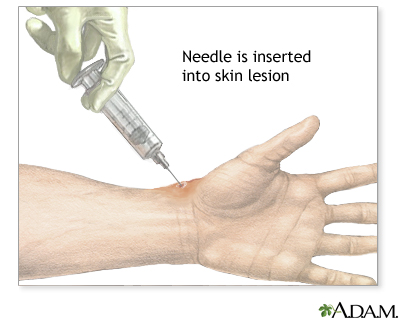Health Library
Skin lesion aspiration
Skin lesion aspiration is the withdrawal of fluid from a skin lesion (sore).
Images

I Would Like to Learn About:
How the Test is Performed
The health care provider inserts a needle into the skin sore or skin abscess, which may contain fluid or pus. Fluid from the sore or abscess is withdrawn. The fluid may be examined under a microscope. A sample of the fluid may also be sent to a lab. There, it is put in a lab dish or other container that contains (culture medium) and watched for growth of bacteria, virus or fungi.
If the sore is deep, the provider may inject or spray numbing medicine (anesthetic) into the skin before inserting the needle.
How to Prepare for the Test
You do not need to prepare for this test.
How the Test will Feel
You may feel a pricking sensation as the needle enters the skin.
In many cases, removing the fluid will lessen pressure within the skin sore and ease pain.
Why the Test is Performed
This test is used to find the cause of a fluid-filled skin lesion. It can be used to diagnose skin infections or cancers.
What Abnormal Results Mean
Abnormal results may be a sign of infection caused by bacteria, fungi, or viruses. Cancer cells may also be seen.
Risks
There is a small risk of bleeding, mild pain, or infection.
Related Information
RashesReferences
Chernecky CC, Berger BJ. Biopsy, site-specific - specimen. In: Chernecky CC, Berger BJ, eds. Laboratory Tests and Diagnostic Procedures. 6th ed. St Louis, MO: Elsevier Saunders; 2013:199-202.
Marks JG, Miller JJ. Dermatologic therapy and procedures. In: Marks JG, Miller JJ, eds. Lookingbill and Marks' Principles of Dermatology. 6th ed. Philadelphia, PA: Elsevier; 2019:chap 4.
BACK TO TOPReview Date: 11/30/2022
Reviewed By: Ramin Fathi, MD, FAAD, Director, Phoenix Surgical Dermatology Group, Phoenix, AZ. Also reviewed by David C. Dugdale, MD, Medical Director, Brenda Conaway, Editorial Director, and the A.D.A.M. Editorial team.
 | A.D.A.M., Inc. is accredited by URAC, for Health Content Provider (www.urac.org). URAC's accreditation program is an independent audit to verify that A.D.A.M. follows rigorous standards of quality and accountability. A.D.A.M. is among the first to achieve this important distinction for online health information and services. Learn more about A.D.A.M.'s editorial policy, editorial process and privacy policy. A.D.A.M. is also a founding member of Hi-Ethics. This site complies with the HONcode standard for trustworthy health information: verify here. |
The information provided herein should not be used during any medical emergency or for the diagnosis or treatment of any medical condition. A licensed medical professional should be consulted for diagnosis and treatment of any and all medical conditions. Links to other sites are provided for information only -- they do not constitute endorsements of those other sites. No warranty of any kind, either expressed or implied, is made as to the accuracy, reliability, timeliness, or correctness of any translations made by a third-party service of the information provided herein into any other language. © 1997- 2025 A.D.A.M., a business unit of Ebix, Inc. Any duplication or distribution of the information contained herein is strictly prohibited.
